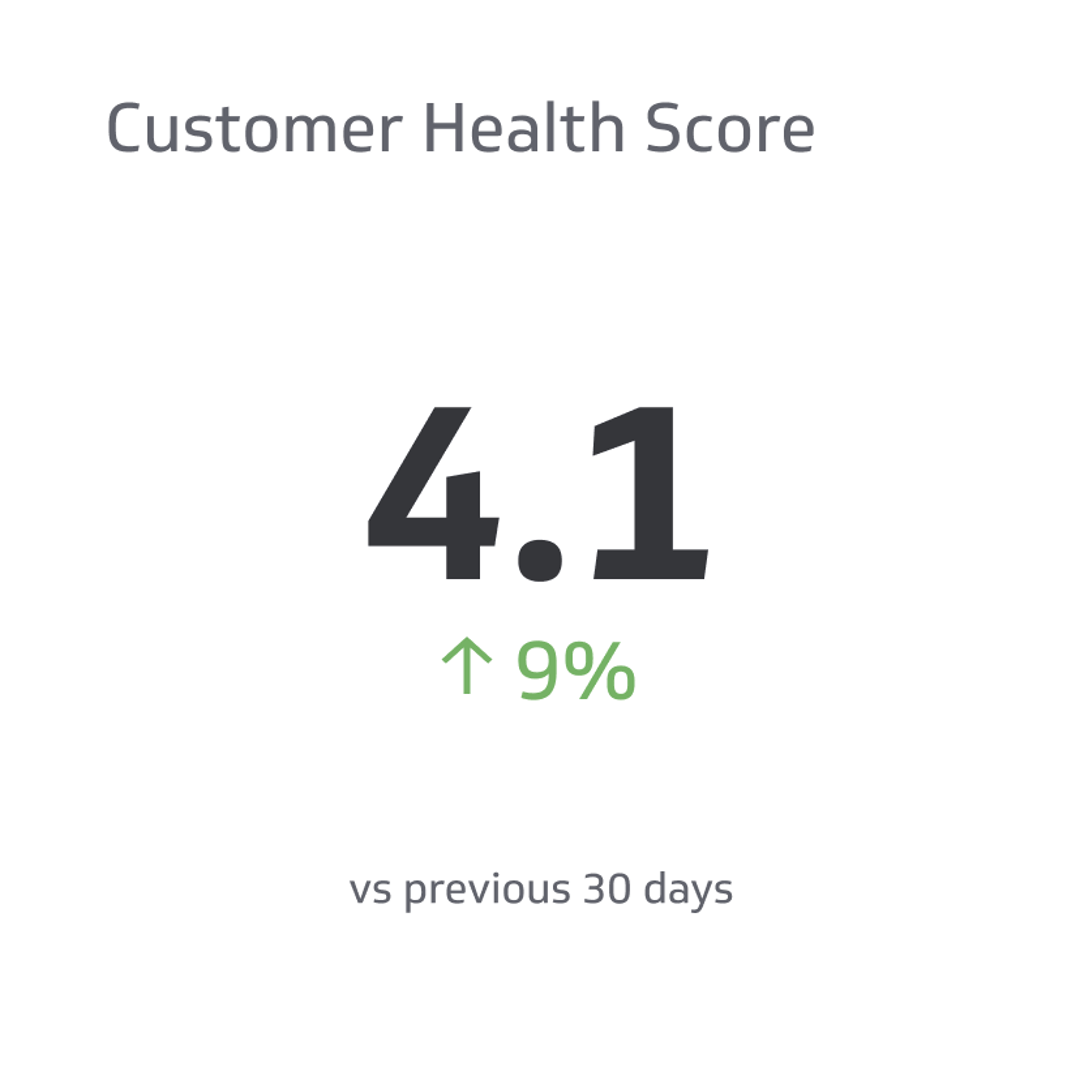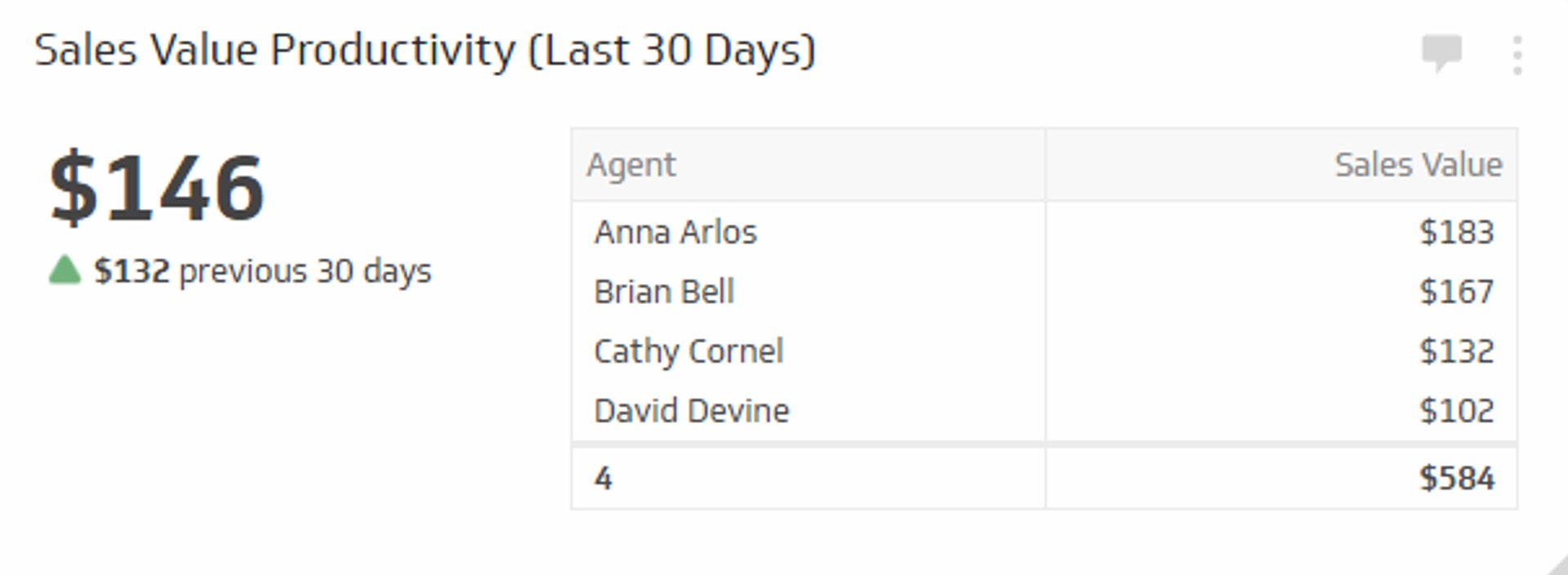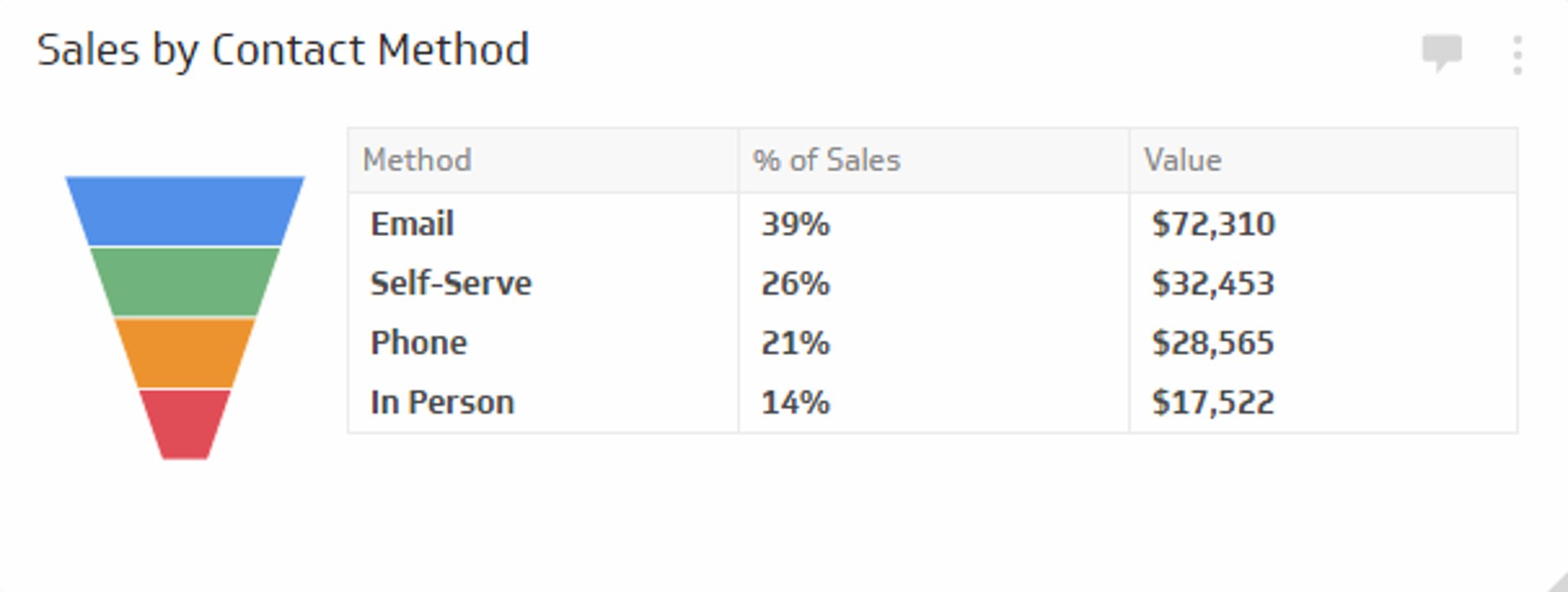Customer Health Score
By leveraging a composite score that considers factors like customer behavior, engagement, feedback, and relevant data points, companies can gain valuable insights into the well-being of their customer base.
Track all your Sales KPIs in one place
Sign up for free and start making decisions for your business with confidence.

Have you heard of a customer health score? It is a vital metric for businesses to track the overall satisfaction, loyalty, and likelihood of retention of their customers.
By leveraging a composite score that considers factors like customer behavior, engagement, feedback, and relevant data points, companies can gain valuable insights into the well-being of their customer base. Measuring customer health score is crucial to ensuring customer satisfaction, identifying areas for improvement, and optimizing customer success strategies.
This article aims to provide a comprehensive overview of customer health score, emphasizing its significance and outlining effective measurement techniques. Furthermore, we will explore strategies businesses can employ to enhance their customer health scores, enabling them to comprehend customer needs better and deliver exceptional experiences. So let's get started!
Factors of Customer Health Score
When exploring customer health scores, it's essential to inquire about the factors influencing high or low scores. To measure these scores, businesses analyze various factors that contribute to the overall health of their customer base. These factors can be dissected into key metrics, offering insights into the organization's effectiveness in serving its customers.
Customer Behavior
Behavior plays a crucial role in assessing customer satisfaction. To measure customer health scores effectively, businesses need to comprehend how customers engage with their products or services. This involves analyzing factors like usage patterns, login frequency, and feature adoption.
For instance, consistent usage of a specific feature indicates high satisfaction with that aspect of the product. Conversely, if customers are not using a particular feature, it could be an area for improvement. This way, tracking customer behavior provides valuable insights into their future actions and reactions to business changes, leading to a more comprehensive understanding of their needs.
Customer Feedback
Customer feedback is valuable for businesses seeking to enhance their customer experience. This feedback can be obtained through various means, such as surveys, reviews, and interactions with customer support. When effectively analyzed, this feedback yields insights into customer sentiment and satisfaction, enabling businesses to make targeted improvements.
Crafting surveys strategically is of utmost importance to ensure that the obtained information aligns with the business's needs. By carefully designing survey questions, businesses can extract the specific information required to comprehensively understand customer preferences, pain points, and areas for improvement.
Account Health
The health of a customer's account is a crucial factor in determining their overall satisfaction and loyalty toward your business. Apart from the quality of your product or service, factors such as billing history, account activity, and contract renewal dates can also affect the customer's health score.
A customer with a long account history who consistently pays their bills on time will likely be more loyal and satisfied than a customer who hasn't. Therefore, understanding the indicators of a "healthy" and "unhealthy" customer can help you identify potential issues and improve your business's performance.
Engagement
Assessing the level of customer engagement with your brand is crucial in determining their loyalty and the likelihood of retaining them. Measuring metrics such as social media engagement, open email rates, and event attendance can provide valuable insights into customer behavior.
A decline in these rates may indicate a need to evaluate your business practices. For instance, if a customer frequently attends events or interacts with your brand on social media, it could mean high engagement and satisfaction.
Tools and Resources
To effectively measure customer health, it's beneficial to leverage the wide range of tools and resources available to businesses. Customer success software, analytics tools, and customer feedback platforms offer valuable insights into customer behavior and satisfaction.
Utilizing these tools allows for automated tracking of key sales metrics and enables targeted surveys and sentiment analysis. Plus, the availability of automated features simplify the data collection process, making it easier to gather relevant information.
Measuring Customer Health Score
Businesses need to take several steps to measure customer health scores, each tailored to consider the key metrics discussed earlier. These steps include:
- Creating a scoring system: The first step is to develop a scoring system that assigns numerical values to each metric. This system should align with the business and its customer base. For instance, a software company may prioritize feature adoption, while a retail store may prioritize customer feedback.
- Setting benchmarks and goals: Once the scoring system is in place, businesses must establish benchmarks and goals to measure their customer health score. This involves setting targets for each metric, such as a specific level of engagement or customer satisfaction rating.
- Analyzing the data and interpreting the results: After collecting data on each metric, businesses should analyze the results to gain valuable insights into their customer health score. This includes identifying trends, areas for improvement, and potential reasons for low scores.
- Continuous monitoring and adjusting of customer health score: Customer health score is not a one-time measurement but a continuous process. Businesses should regularly monitor and adjust their scoring system based on changes in their customer base and evolving business objectives.
Benefits of Measuring Customer Health Score
There are a wide variety of benefits that businesses can receive from measuring customer health.
Improved Customer Retention
Measuring customer health score enables businesses to identify customers at risk of churning or leaving. This valuable information empowers businesses to take proactive measures to retain these customers.
By providing a superior customer experience and promptly addressing any concerns or issues, businesses can enhance customer loyalty and increase the overall lifetime value of each customer.
Increased Customer Satisfaction
By tracking customer health scores, businesses can pinpoint areas where they may be falling short and make necessary improvements to boost customer satisfaction.
Satisfied customers are more inclined to recommend a business to others, leading to increased advocacy and positive word-of-mouth referrals. This, in turn, can attract new customers and foster stronger relationships with existing ones.
Understanding Customer Needs
Customer health scores provide valuable insights into customer behavior, preferences, and needs. Analyzing this data helps businesses gain a deeper understanding of their customers and their expectations.
By leveraging these insights, businesses can tailor their offerings and customer experiences to better align with their customers' needs, resulting in increased satisfaction and stronger customer loyalty.
Proactively Address Issues
Monitoring customer health scores allows businesses to identify and address issues before they escalate into major problems. By detecting early warning signs through customer health scoring, businesses can promptly respond to customer concerns, resolve issues, and prevent negative experiences that could lead to customer churn.
How to Improve Customer Health Score
Improving customer health scores is crucial for businesses to enhance customer satisfaction and foster loyalty. Here is a brief overview of each strategy and its potential benefits:
Find Areas of Improvement
To identify areas of improvement, businesses should analyze key metrics and customer feedback to pinpoint where customers may be experiencing issues or dissatisfaction.
By examining data such as customer support tickets, survey responses, or usage patterns, businesses can uncover pain points or areas where customers may not be satisfied. For example, low engagement with certain features of a product might indicate that those features do not meet customer needs or are not user-friendly.
Create an Action Plan
Creating a comprehensive action plan is crucial for effectively implementing changes and improving customer health scores. This involves setting specific goals and objectives that align with addressing identified issues. The action plan should outline the steps, resources, and timeline required to achieve these objectives.
Businesses may need to allocate additional resources, such as hiring additional customer support staff or investing in new technology, to implement the necessary changes. Establishing a realistic timeline ensures the goals are met within a reasonable timeframe and allows for progress tracking and adjustments as needed.
Personalize Customer Interactions
Personalizing customer interactions is an effective strategy to improve customer satisfaction and foster loyalty. Businesses can tailor their interactions to meet customer preferences and needs by leveraging customer data and insights.
This can involve customizing product recommendations, offering personalized discounts or promotions based on purchase history, or addressing customers by name. Personalization creates a sense of being valued and understood, enhancing the overall customer experience.
Using Customer Feedback
Customer feedback is a valuable tool for businesses to understand customer experiences and identify areas for improvement. Regularly collecting and analyzing customer feedback through surveys, reviews, or direct communication channels helps businesses gain insights into customer preferences, pain points, and expectations.
By actively listening to customer concerns and suggestions, businesses can address their needs and make the necessary changes to enhance customer satisfaction. This may involve product design improvements, process optimizations, or updates to customer support procedures. Promptly addressing customer concerns and providing effective solutions not only improves the customer experience but also boosts customer loyalty and retention.
Examples of Measuring Customer Health Score
Here are a few examples that illustrate the practical application and benefits of measuring customer health scores:
Company X - Software-as-a-Service (SaaS) Company
Company X noticed that many new customers were struggling to effectively use their platform, which put them at risk of churn. To address this, they implemented a personalized onboarding process. This involved providing customized guidance and support to each new customer based on their specific goals.
By doing so, they increased adoption rates and improved customer satisfaction, leading to a higher customer health score. This proactive approach helped Company X retain customers and enhance their overall experience with the platform.
Company Y - Retail Chain
Company Y was facing challenges with low customer satisfaction ratings and high churn rates. To tackle these issues, they implemented a comprehensive customer feedback program. This program allowed them to collect customer feedback at various touchpoints and analyze it to identify areas for improvement.
By actively listening to customer concerns and making necessary changes, Company Y was able to improve customer satisfaction, reduce churn rates, and ultimately raise their customer health score.
HubSpot - Marketing Software Company
HubSpot, a leading marketing software company, utilizes customer health scores to identify at-risk customers and take proactive measures to prevent churn. HubSpot assesses the overall health of its customer relationships by analyzing factors such as product usage, customer engagement, and support interactions.
This enables them to intervene early and provide targeted support to customers showing signs of dissatisfaction or disengagement. By addressing potential issues promptly, HubSpot maintains higher customer retention rates and sustains a healthier customer base.
Airbnb - Home-Sharing Platform
Airbnb, a popular home-sharing platform, relies on customer health scores to track the satisfaction and loyalty of its hosts and guests. By monitoring various metrics such as ratings, reviews, and booking frequency, Airbnb gains insights into the overall health of its customer relationships.
This helps them identify areas for improvement in their service offerings, resolve any issues, and enhance the overall customer experience. By consistently measuring customer health, Airbnb can maintain a high level of customer satisfaction and loyalty, which is crucial for their business success.
Challenges to Measure Customer Health
While measuring customer health scores can provide numerous benefits, there are also several challenges that businesses may face.
Identifying Relevant Metrics
One of the primary challenges is determining the appropriate metrics to track when measuring customer health scores. Different businesses have varying customer success goals, making it difficult to establish universal metrics. Businesses must carefully identify and define the key metrics aligning with their specific objectives and customer satisfaction drivers.
Weighing and Scoring Metrics
Assigning weights to different metrics and creating a comprehensive scoring system can be complex. Some metrics may be more critical than others, and determining the appropriate weightage requires careful consideration. Businesses must establish a methodology for weighting and scoring metrics to ensure a fair representation of customer health.
Limited Data Availability
Not all customer data may be readily accessible or available, particularly for businesses in certain industries. This limited data availability can hinder the accuracy and completeness of customer health scores.
Obtaining comprehensive and relevant customer data may require overcoming technical or logistical challenges, such as integrating disparate systems or implementing effective data collection processes.
Establishing Clear Benchmarks and Goals
Setting clear benchmarks and goals is essential for interpreting and acting on customer health score data. However, it can be challenging to establish benchmarks without sufficient historical data or a clear understanding of what constitutes a successful outcome.
Businesses must invest time and effort in defining realistic benchmarks and goals to track progress and measure success effectively.
Limitations of Customer Health Scores
Customer health scores have inherent limitations. They may not capture external factors influencing customer behavior, such as market trends or competitor actions. Moreover, customer health scores may not fully capture the emotional or subjective aspects of the customer experience.
Businesses should be aware of these limitations and supplement customer health scores with additional qualitative and quantitative feedback mechanisms to comprehensively understand customer sentiment.
Measuring Impact and Attribution
Linking specific customer success initiatives to changes in customer health scores can be challenging. It may be difficult to isolate the impact of individual actions or determine the exact contribution of each initiative to changes in customer health scores.
Measuring the effectiveness of customer success initiatives requires careful tracking, data analysis, and consideration of multiple factors influencing customer health.
Future Trends
As technology continues to evolve, several future trends will likely impact how businesses measure and improve customer health scores.
Artificial intelligence (AI) and machine learning (ML) are increasingly crucial in analyzing customer data and identifying patterns and trends. By leveraging these technologies, businesses can gain deeper insights into customer behavior and preferences and create more accurate and effective customer health score metrics.
While customer health score has traditionally been used to identify at-risk customers, there is a growing trend toward proactive customer success initiatives. By focusing on proactive measures to improve customer satisfaction and loyalty, businesses can prevent churn and create more positive customer experiences.
As more customer data is collected and analyzed, there is also a growing focus on privacy and security. Businesses must ensure that they collect and use customer data ethically and transparently and take steps to protect customer privacy and security.
Final Thoughts
To sum up, measuring customer health scores is vital for businesses to enhance customer satisfaction and loyalty. By establishing key metrics, implementing improvement strategies, and leveraging customer feedback, businesses can actively work towards improving their customer health scores and delivering exceptional experiences.
Continuous monitoring and adaptation are essential to meet evolving customer needs and preferences. By consistently analyzing data and adjusting strategies, businesses can provide the best possible experience, fostering long-term customer relationships and success.
Related Metrics & KPIs



